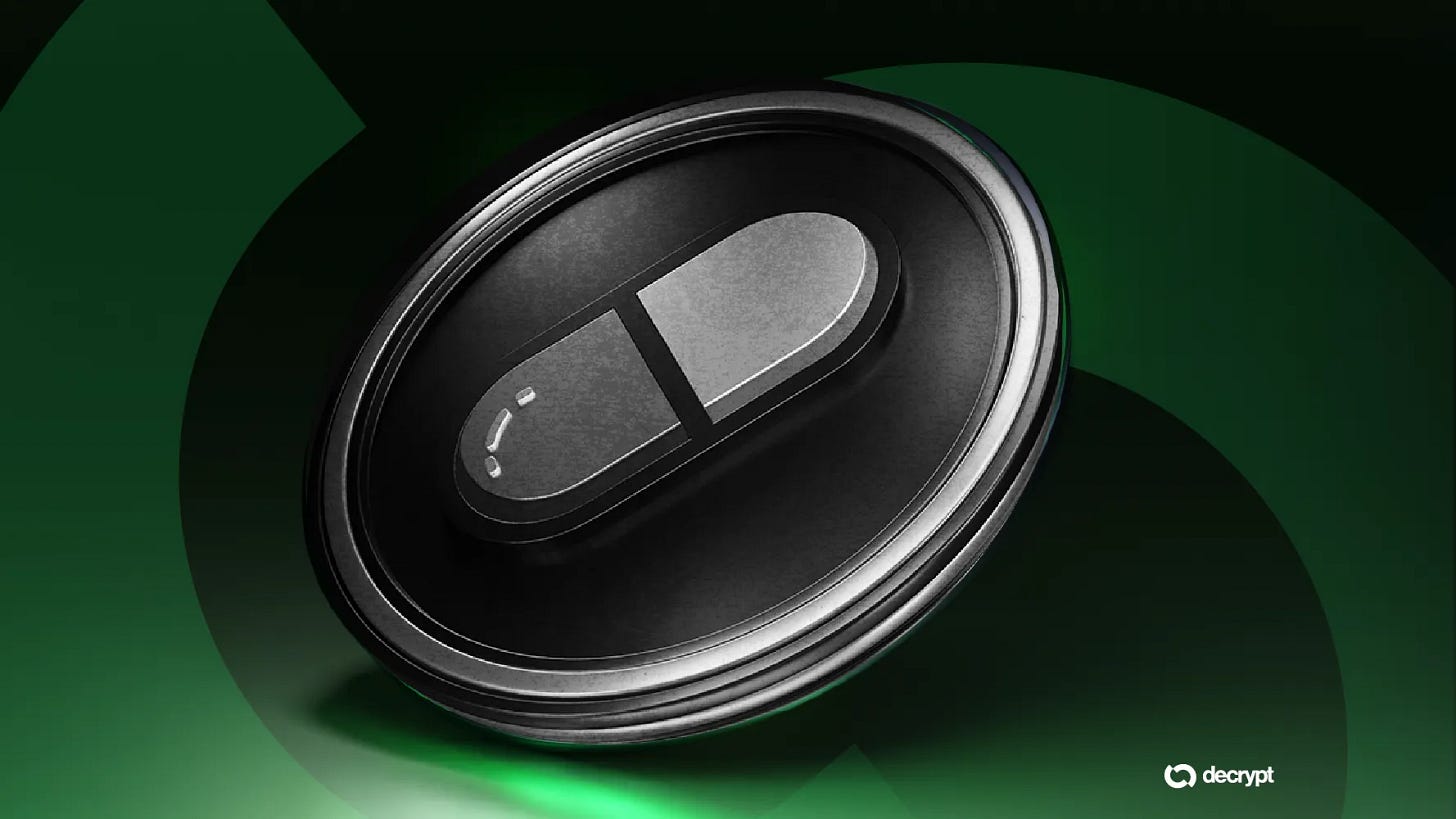The Cleveland Guardians finally broke their brutal 10-game losing streak yesterday with a win over the Astros. With the All-Star break coming, here’s hoping the Guardians can regroup. But you're not here for baseball — you're here for crypto. So let’s dive in.
🪙 Controversial Crypto Plan to Sell Gaza Land Sparks Outrage
🤖 Solana Trading Bot Axiom Acquires Cursor, Generates $150M+ Revenue
🏛️ Crypto Lobby Urges Congress to Pass the Clarity Act
🏦 Metaplanet Pursues Digital Bank Buyouts in Bold Bitcoin Strategy
🚨 Solana Meme Coin Platform Pump.Fun Cancels $600M Token Sale After Teaser
📉 Trader Cobb & Market Training via The Grow Me Co
Gaza Redevelopment Tokenization Sparks Outrage
"Critics accuse developers and political figures of profiteering from suffering."
A leaked proposal titled The Great Trust suggested tokenizing Gaza’s land and selling it via fractionalized crypto tokens. The plan, developed by Boston Consulting Group and backed by the Tony Blair Institute, pitched turning Gaza into a futuristic blockchain and trade hub. Its goals included launching luxury resorts (e.g., "Gaza Trump Riviera") and Elon Musk-themed "SmartZones," alongside a Gaza-based stablecoin.
What set off a firestorm was the plan’s suggestion to incentivize the displacement of up to 500,000 Palestinians. Though firms like Plume Network and Savea noted that real estate tokenization is standard practice, experts and activists lambasted this specific plan as dehumanizing, exploitative, and disconnected from the region’s realities.
In the wake of public outrage, both the Blair Institute and BCG distanced themselves from the plan. While some claim this was merely headline bait, others believe it was a legitimate (and deeply flawed) proposal. We asked listeners for their take — was this real, or just a PR stunt gone wrong?
Solana-Based Trading Bot Axiom Explodes in Popularity
"That is huge."
Axiom, a trading bot platform built on Solana, is now the top player in its category. Since its February 2025 launch, it has generated over $150 million in fees and processed more than $15 billion in volume. It controls 72% of all Solana bot trading, up from just 2% in February. It recently posted $1.75 million in a single day and has quickly become the fastest startup in Y Combinator’s history to hit $100 million in revenue.
How? Axiom has largely avoided the social media spotlight, instead focusing on platform incentives: fee rebates, referral bonuses, and a points system for future airdrops. It charges between 0.75–1% per trade but rewards power users with Solana-based kickbacks.
The rise of Axiom marks a serious shift in on-chain automation and bot-based DeFi. With over 650,000 wallets already using the platform, it seems primed for continued growth — and for setting the tone in a competitive space once dominated by BullX and Photon.
Crypto Week and the Clarity Act Loom Large in Washington
Coinbase and 65 other crypto orgs — including OpenSea and Dapper Labs — have penned a letter to Congress urging passage of the Clarity Act during "Crypto Week," starting July 14th. The bill would move crypto regulatory power primarily to the CFTC, reducing the SEC’s control to only securities-related oversight.
The Clarity Act has already passed two House committees and is headed for a full House vote. If approved, it moves to the Senate. Senator Tim Scott hopes to pass a market structure bill by September, but there’s significant pushback. Democrat Maxine Waters labeled the bill “rushed and overly complicated,” warning it would legitimize risky ventures too closely tied to President Trump — whose crypto efforts have allegedly enriched his family by over $620 million.
Democrats have also stalled progress on the Genius Act, another crypto bill favored by Trump, aiming to pass it before Congress’s August recess. All eyes are on Capitol Hill next week.
MetaPlanet Bets Big on Bitcoin Strategy
"They're racing to accumulate Bitcoin during what he calls a Bitcoin gold rush."
MetaPlanet, a Japanese company once focused on hotels, is pivoting hard into Bitcoin. CEO Simon Djuravic laid out plans to acquire 210,000 BTC — 1% of the total eventual supply — by 2027. With this BTC treasury, MetaPlanet aims to leverage the assets to acquire cash-generating businesses, including possibly a digital bank in Japan.
The company prefers using Bitcoin as collateral for growth rather than issuing debt, and recently purchased $237 million worth (2,204 BTC) at an average of $107,700 per coin. Despite low revenue, MetaPlanet’s market cap has skyrocketed over 345% this year to $7 billion. Their strategy mirrors Michael Saylor’s approach with MicroStrategy — accumulate, hold, and build.
Pump.Fun Rumored to Launch Its Own Token
"I think personally that this token is gonna go crazy."
Solana’s memecoin launchpad, Pump.Fun, may be preparing to launch its own token, per a since-deleted listing on Gate.io. The details: 150 billion tokens (15% of total supply) at $0.00004 each, for a $600 million public sale and a $4 billion fully diluted valuation.
The 72-hour sale was set to begin July 12th, first-come-first-served, with no max buy limit. While unconfirmed, speculation surged due to Pump.Fun’s popularity as the home of memecoins like Fartcoin and Peanut. The platform has previously denied token launch plans, but the listing has crypto sleuths thinking otherwise.
If the token materializes, expect a volatile launch and strong community-driven speculation.
Listener Questions
Liam on Fed Rate Cuts:
Liam wrote in to challenge Trader Cobb’s take, saying that low unemployment suggests a healthy economy, making a July rate cut unlikely. I agree. If GDP is rising and jobs are strong, why would the Fed fire its only major bullet? However, layoffs are ticking up — Microsoft recently laid off over 9,000 workers. If this becomes a trend, sentiment and action may shift. For now, I think Liam’s analysis is solid.
Philip on Substack vs. X (Twitter):
Philip prefers Substack, especially for the crypto-curious. X doesn’t give users enough room to ask thoughtful questions or express nuanced ideas. I agree — Substack feels like the best place for in-depth commentary and quality interaction. I hope it stays that way.
Eric on Social Engineering Hacks and “Phreaking”:
Phreaking is the practice of exploiting the telephone system—especially long-distance switching systems—to make free calls, access restricted lines, or explore the phone network. It was all about manipulating tones, pulses, and system quirks rather than cracking passwords or writing malware.
Origins
Timeframe: Late 1950s to the 1980s.
Technology exploited: Analog phone systems, specifically the in-band signaling used by AT&T and other telcos. This meant control signals (like the tone to route a call) traveled on the same channel as your voice.
Notable targets: Long-distance lines, operator systems, and international trunk lines—these were expensive to use and therefore attractive to bypass.
Techniques
Phreakers used devices and tricks such as:
Blue Box: An electronic device that generated 2600 Hz tones and other multi-frequency (MF) signals to control phone switching systems. It let phreakers trick the system into thinking a call was still active after it ended, giving them a free ride on the network.
Red Box: Simulated the tones made by payphones when coins were inserted, allowing free calls from payphones.
Black Box: Manipulated voltage to make incoming calls appear unanswered (and therefore free).
Green Box, Beige Box, etc.: Each with specific functions like simulating coin return signals or giving access to phone lines.
Whistles: Famously, a toy whistle found in Cap’n Crunch cereal boxes produced a perfect 2600 Hz tone—the exact frequency used to signal the end of a call. That’s how John Draper, aka “Captain Crunch,” became a legendary phreaker.
Notable Figures
John Draper (Captain Crunch): Used the Cap’n Crunch whistle to access phone systems and inspired a generation of phreakers.
Steve Wozniak & Steve Jobs: Before founding Apple, they built and sold Blue Boxes to make free long-distance calls. Wozniak has said that if it weren’t for the Blue Box, Apple might never have existed.
2600: The Hacker Quarterly: Named after the 2600 Hz tone, it became a major publication for hackers and phreakers.
Why It Worked
Back then, telecom systems weren’t secured—the network trusted users too much. All you had to do was send the right signals. Once digital switching and out-of-band signaling (like SS7) were introduced, these tricks stopped working.
Legacy
Phreaking was the cultural and technical precursor to modern hacking.
It gave birth to the hacker ethos: curiosity, freedom of information, anti-authoritarianism.
Many early phreakers became key figures in tech and cybersecurity.
Modern equivalents include VoIP hacking, SIM swapping, or PBX fraud—but the romanticism of whistling into a phone to reach Tokyo? That’s pure hacker history.
My Take
The Gaza tokenization story is disturbing — both in concept and tone-deafness. Even if it was never truly actionable, it's a symptom of tech opportunism gone too far. Using crypto to solve real-world problems is fine.
Axiom’s rise is impressive. It shows how strong incentives, rather than hype, can drive adoption. Still, I worry we may see oversaturation in bot trading tools. Coinbase and friends pushing the Clarity Act is a step forward. Regulation is overdue, but Congress better get it right — not just rush it for political points.
MetaPlanet might be wild, but I like it. Their playbook is bold, and it’s working. As for Pump.Fun — I wouldn’t bet the farm, but I wouldn’t ignore it either.
Crypto Prices – July 8, 2025
Bitcoin (BTC): $108,835
Market Cap: $2.26 trillion
24h: +0.21% | 7d: +1.77%
Ethereum (ETH): $2,584
Market Cap: $311.4 billion
24h: +0.70% | 7d: +5.50%
Tether (USDT): $1.00
XRP: $0.229 (down 1.5%)
Binance Coin (BNB): $661 (down 0.2%)
Solana (SOL): $151 (down 1.0%)
USD Coin (USDC): $1.00
Tron (TRX): $0.286 (down 0.2%)
Dogecoin (DOGE): $0.169 (down 0.3%)
Cardano (ADA): $0.584 (down 0.7%)
Total Crypto Market Cap: $3.37 trillion
Happy HODLing, Everyone.















